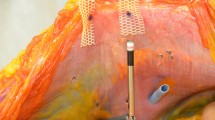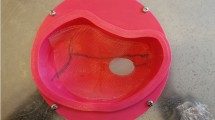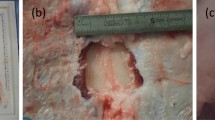Abstract
Background
Laparoscopic inguinal hernia repair can be performed using light- or heavyweight meshes. Apart from the size of the mesh, its friction coefficient (μ0) and flexural stiffness are of crucial importance to avoidance of hernia recurrence.
Methods
In the current biomechanical study, tensile tests were performed to determine the ultimate tensile strength and modulus of elasticity of six lightweight meshes and six heavyweight meshes for laparoscopic inguinal hernia repair. To determine their friction coefficient (μ0), the meshes were placed between a resected peritoneum and groin muscles during an autopsy. Meshes measuring 15 × 10 cm in size then were used in a hernia model with an opening size of 1.5, 3, or 5 cm.
Results
The ultimate tensile strength and modulus of elasticity were significantly lower in the lightweight mesh group than in the heavyweight mesh group. The mean friction coefficient (μ0) of the meshes was 0.4. Given an opening of 1.5 cm, all meshes remained adequately stable. At opening sizes of 3 and 5 cm, the lightweight meshes flexed on the average by 3.16 ± 0.4 mm and 10.40 ± 2.5 mm, respectively. Heavyweight meshes, on the other hand, were significantly less flexible. Their mean flexure was, respectively, 0.34 ± 0.2 mm and 3.97 ± 0.7 mm (p < 0.001).
Conclusion
Stable meshes are characterized by a small degree of flexure and do not slide into the gap even when subjected to repetitive loads. Therefore, in terms of hernia recurrence, meshes with greater flexural stiffness or well-fixed lightweight meshes that adequately overlap the hernia defect can be used for laparoscopic treatment of large inguinal hernias.





Similar content being viewed by others
References
Bellon JM, Lopez-Hervas P, Rodriguez M, Garcia-Honduvilla N, Pascual G, Bujan J (2006) Midline abdominal wall closure: a new prophylactic mesh concept. J Am Coll Surg 203:490–497
Burger JW, Luijendijk RW, Hop WC, Halm JA, Verdaasdonk EG, Jeekel J (2004) Long-term follow-up of a randomized controlled trial of suture versus mesh repair of incisional hernia. Ann Surg 240:578–583
Luijendijk RW, Hop WC, van den Tol MP, de Lange DC, Braaksma MM, IJzermans JN, Boelhouwer RU, de Vries BC, Salu MK, Wereldsma JC, Bruijninckx CM, Jeekel J (2000) A comparison of suture repair with mesh repair for incisional hernia. N Engl J Med 343:392–398
Klinge U, Conze J, Limberg W, Brucker C, Ottinger AP, Schumpelick V (1996) Pathophysiology of the abdominal wall. Chirurg 67:229–233
Horstmann R, Hellwig M, Classen C, Rottgermann S, Palmes D (2006) Impact of polypropylene amount on functional outcome and quality of life after inguinal hernia repair by the TAPP procedure using pure, mixed, and titanium-coated meshes. World J Surg 30:1742–1749
Cobb WS, Burns JM, Peindl RD, Carbonell AM, Matthews BD, Kercher KW, Heniford BT (2006) Textile analysis of heavy weight, midweight, and lightweight polypropylene mesh in a porcine ventral hernia model. J Surg Res 136:1–7
Cobb WS, Kercher KW, Heniford BT (2005) The argument for lightweight polypropylene mesh in hernia repair. Surg Innov 12:63–69
O’Dwyer PJ, Kingsnorth AN, Molloy RG, Small PK, Lammers B, Horeyseck G (2005) Randomized clinical trial assessing impact of a lightweight or heavyweight mesh on chronic pain after inguinal hernia repair. Br J Surg 92:166–170
Eklund A, Rudberg C, Leijonmarck CE, Rasmussen I, Spangen L, Wickbom G, Wingren U, Montgomery A (2007) Recurrent inguinal hernia: randomized multicenter trial comparing laparoscopic and Lichtenstein repair. Surg Endosc 21:634–640
Totté E, Van Hee R, Kox G, Hendrickx L, van Zwieten KJ (2005) Surgical anatomy of the inguinal region: implications during inguinal laparoscopic herniorrhaphy. Eur Surg Res 37:185–190
Kapiris SA, Brough WA, Royston CM, O’Boyle C, Sedman PC (2001) Laparoscopic transabdominal preperitoneal (TAPP) hernia repair: a 7-year two-center experience in 3,017 patients. Surg Endosc 15:972–975
Kes E, Lange J, Bonjer J, Stoeckart R, Mulder P, Snijders C, Kleinrensink G (2004) Protrusion of prosthetic meshes in repair of inguinal hernias. Surgery 135:163–170
Knook MT, van Rosmalen AC, Yoder BE, Kleinrensink GJ, Snijders CJ, Looman CW, van Steensel CJ (2001) Optimal mesh size for endoscopic inguinal hernia repair: a study in a porcine model. Surg Endosc 15:1471–1474
Miserez M, Alexandre JH, Campanelli G, Corcione F, Cuccurullo D, Pascual MH, Hoeferlin A, Kingsnorth AN, Mandala V, Palot JP, Schumpelick V, Simmermacher RK, Stoppa R, Flament JB (2007) The European hernia society groin hernia classification: simple and easy to remember. Hernia 11:113–116
Schumpelick V, Treutner KH, Arlt G (1994) Classification of inguinal hernias. Chirurg 65:877–879
Schmidbauer S, Ladurner R, Hallfeldt KK, Mussack T (2005) Heavy-weight versus low-weight polypropylene meshes for open sublay mesh repair of incisional hernia. Eur J Med Res 10:247–253
Welty G, Klinge U, Klosterhalfen B, Kasperk R, Schumpelick V (2001) Functional impairment and complaints following incisional hernia repair with different polypropylene meshes. Hernia 5:142–147
Tamme C, Garde N, Klingler A, Hampe C, Wunder R, Kockerling F (2005) Totally extraperitoneal inguinal hernioplasty with titanium-coated lightweight polypropylene mesh: early results. Surg Endosc 19:1125–1129
Lovisetto F, Zonta S, Rota E, Mazzilli M, Bardone M, Bottero L, Faillace G, Longoni M (2007) Use of human fibrin glue (Tissucol) versus staples for mesh fixation in laparoscopic transabdominal preperitoneal hernioplasty: a prospective, randomized study. Ann Surg 245:222–231
Inaki N, Waseda M, Schurr MO, Braun M, Buess GF (2007) Experimental results of mesh fixation by a manual manipulator in a laparoscopic inguinal hernia repair model. Surg Endosc 21:197–201
Ferzli GS, Frezza EE, Pecoraro AM Jr, Ahern KD (1999) Prospective randomized study of stapled versus unstapled mesh in a laparoscopic preperitoneal inguinal hernia repair. J Am Coll Surg 188:461–465
Leibl BJ, Schmedt CG, Kraft K, Ulrich M, Bittner R (2000) Recurrence after endoscopic transperitoneal hernia repair (TAPP): causes, reparative techniques, and results of the reoperation. J Am Coll Surg 190:651–655
Cobb WS, Burns JM, Kercher KW, Matthews BD, James Norton H, Todd Heniford B (2005) Normal intraabdominal pressure in healthy adults. J Surg Res 129:231–235
Nienhuijs S, Staal E, Strobbe L, Rosman C, Groenewoud H, Bleichrodt R (2007) Chronic pain after mesh repair of inguinal hernia: a systematic review. Am J Surg 194:394–400
Author information
Authors and Affiliations
Corresponding author
Rights and permissions
About this article
Cite this article
Hollinsky, C., Sandberg, S., Koch, T. et al. Biomechanical properties of lightweight versus heavyweight meshes for laparoscopic inguinal hernia repair and their impact on recurrence rates. Surg Endosc 22, 2679–2685 (2008). https://doi.org/10.1007/s00464-008-9936-6
Received:
Revised:
Accepted:
Published:
Issue Date:
DOI: https://doi.org/10.1007/s00464-008-9936-6




